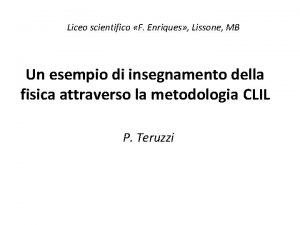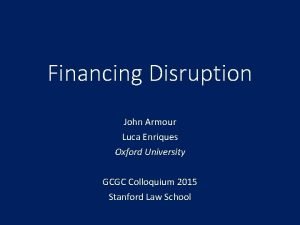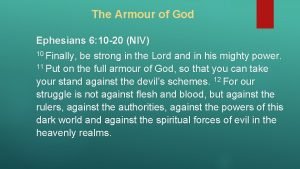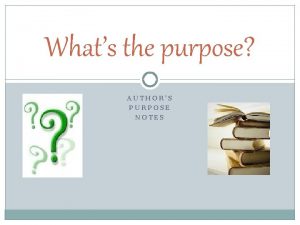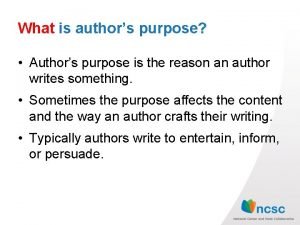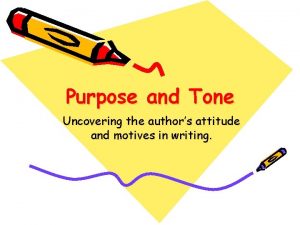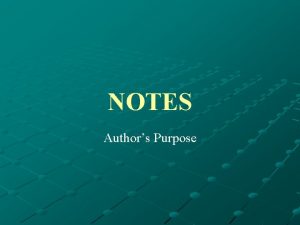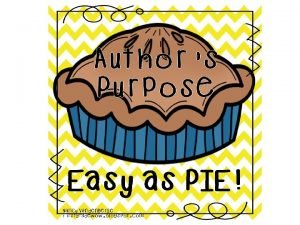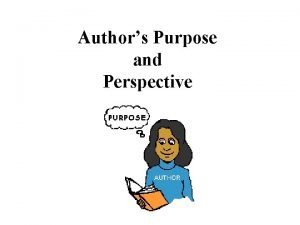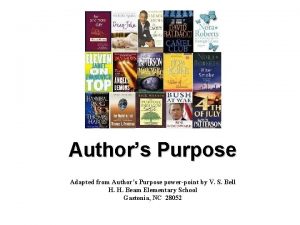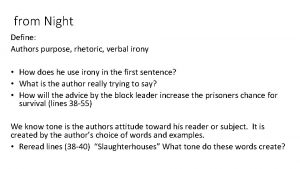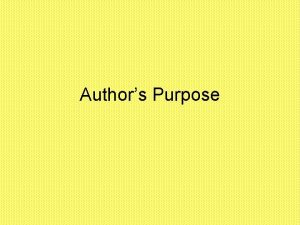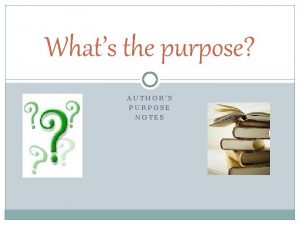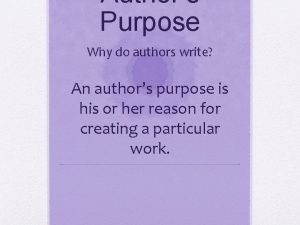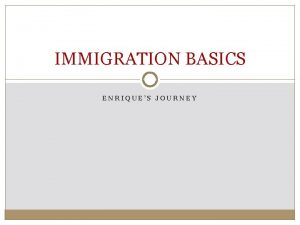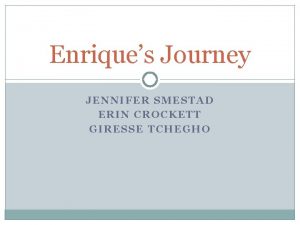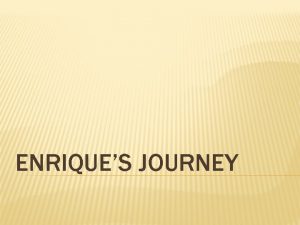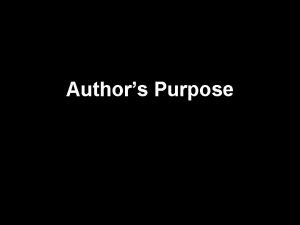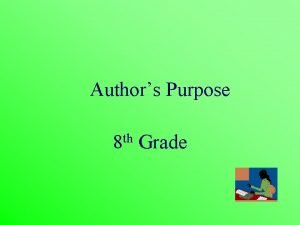AUTHORS PURPOSE ENRIQUES JOURNEY WHY WAS THIS WRITTEN













- Slides: 13

AUTHOR’S PURPOSE ENRIQUE’S JOURNEY

WHY WAS THIS WRITTEN?

BASIC AUTHOR’S PURPOSE • TO INFORM • TO PERSUADE • TO ENTERTAIN

BASIC AUTHOR’S PURPOSE CLUES �Explains or gives you �TO INFORM �TO PERSUADE �TO ENTERTAIN information about a topic �Presents author’s own opinions, feelings, beliefs �Makes you feel emotions (e. g. , happy, sad, scared)

AUTHOR’S MESSAGE THE “BIG IDEA”; WHAT THE AUTHOR IS TRYING TO TELL THE READER

FACT VS. OPINION • FACT = STATES SOMETHING THAT HAPPENS, HAS HAPPENED, OR IS CERTAIN TO BE TRUE • EX: A lunar eclipse happens when the moon aligns exactly with the earth and sun. • OPINION = STATES SOMETHING THAT IS BELIEVED TO HAVE OCCURRED, IS BELIEVED TO EXIST, OR IS BELIEVED TO BE TRUE • EX: The teacher gave a pop quiz because she got mad at the class.

AUTHOR’S BIAS = A PREJUDICE, A PRECONCEIVED JUDGMENT, OR AN OPINION FORMED WITHOUT SUFFICIENT KNOWLEDGE AUTHOR’S BIAS THE FAVORING OF ONE SIDE, POSITION, OR BELIEF; BEING PARTIAL

AUTHOR’S BIAS 1. OMISSION / SELECTION 2. PLACEMENT 3. STATISTICS 4. WORD CHOICE 5. TONE

AUTHOR’S BIAS: OMISSION/SELECTION �OMISSION = the cutting of certain facts and/or details from a story �SELECTION = the choosing of certain facts and/or details for a story �Changes how readers think about the story �Selective details to support author’s purpose �Need to read several different sources for holistic understanding

AUTHOR’S BIAS: PLACEMENT �PLACEMENT = the decision of which information to present first, second, third, etc. �More important stories chosen to be seen first (think headline news!) �Less important stories chosen to be at the end �Within a story, most important/convincing facts placed first �Contradictory statements placed after

AUTHOR’S BIAS: STATISTICS �BIASED STATISTICS: the manipulation of statistics to change the way we think about them � EX#1: “The fundraiser for the school raised only 1100. � EX#2: “The fundraiser for the school raised over 1100. � EX#1: “A crowd of more than 900 attended the protest. ” � EX#2: “Fewer than 1, 000 showed up to protest. ” �Decision of which numbers to present �Adjectives to describe numbers �Holistic vs. limited statistics

AUTHOR’S BIAS: WORD CHOICE �WORD CHOICE = the author’s purposeful usage of words to write about and describe happenings • Positive vs. negative words • Connotation vs. denotation • Word choice creates tone �FACT = Frank spends very little money. • EX#1: Frank is thrifty. (positive) • EX#2: Frank is a cheapskate. (negative)

AUTHOR’S BIAS: TONE �TONE = the author’s attitude toward a subject, a character, or the reader �Examples: silly, sarcastic, angry, annoyed, proud, bored, etc. �WORDS CONVEY TONE!!!!!!! �DETAILS CONVEY TONE!!!!! �Tone developed from word choice!
 Luca enriques
Luca enriques Sonia richie
Sonia richie Andreas carlsson bye bye bye
Andreas carlsson bye bye bye Liceo scientifico enriques
Liceo scientifico enriques Luca enriques
Luca enriques Armour of god ephesians 6 10-20
Armour of god ephesians 6 10-20 Whats authors purpose
Whats authors purpose Purpose of the author
Purpose of the author Author's attitude words
Author's attitude words Definition of authors purpose
Definition of authors purpose Author purpose pie
Author purpose pie Pie song author's purpose
Pie song author's purpose Authors purpose powerpoint
Authors purpose powerpoint Identifying irony worksheet answer key
Identifying irony worksheet answer key



